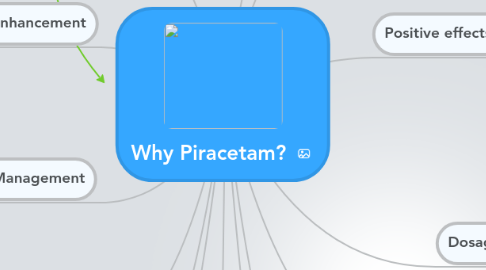Why Piracetam?
Jonathan Roselandにより


1. Memory Enhancement
1.1. Improves function of Acetylcholine
1.2. Recognition time
1.3. The treatment with Piracetam improves learning, memory, brain metabolism, and capacity.
1.4. Long term memory
1.5. Spatial memory
2. Addiction
2.1. Alcoholism
3. Stress Management
3.1. Anti-inflammatory effects
3.2. Fights oxidative stress
3.3. Mitochondrial dysfunction
4. Side Effects
4.1. Excessive doses can cause mild headaches or anxiety without supplementing Choline simultaneously
4.2. Do not use if you are pregnant/breastfeeding.
4.3. Don't drink alcohol on it
5. Other Names
5.1. Nootropyl
5.2. Nootropil
5.3. Lucetam
5.4. Oikamid
5.5. Geratam
5.6. Biotropil
5.7. Breinox
5.8. Dinagen
5.9. Noostan
6. Productivity
6.1. Adding more productive hours to the day and more productivity to those hours
6.2. Energy 'buzz'
6.3. Artistic productivity
6.4. Increases cerebral blood flow
7. Anti Aging
7.1. Mitochondrial stabilization
7.2. Membrane fluidity
8. Vasodilation
8.1. Increased blood to the brain
8.2. Increased oxygen to the brain
8.3. Don't drink alcohol on it
9. Boosts activity in Corpus Callosum
9.1. Interhemispheric communication
9.1.1. 'Right brain'
9.1.2. 'Left brain'
9.2. Boosts athletic performance
10. Positive effects on
10.1. Depression
10.2. Anxiety
10.3. Epilepsy
10.4. Dyslexia
10.5. Post-stroke aphasia
10.6. Schizophrenia
10.7. Dementia
10.8. Myoclonus
10.9. Cognitive decline
10.9.1. Heart surgery
10.9.2. Brain surgery
10.10. Prevention of postoperative cognitive dysfunction
11. Affordable
11.1. Monthly supply starts at $18
11.2. 500 Grams for $40
12. Other Racetams
12.1. Aniracetam
12.2. Noopept
12.3. Oxiracetam
12.4. Phenylpiracetam
12.5. Pramiracetam
13. Dosage
13.1. Low
13.1.1. 800 - 1600 Milligrams Daily
13.2. Medium
13.2.1. 2 -3 Grams Daily
13.3. High
13.3.1. 4 - 6 Grams Daily
13.4. Extreme
13.4.1. 12 - 24 Grams Daily
14. Cofactors
14.1. An acetylcholine precursor
14.1.1. Choline
14.1.2. Alpha-GPC
